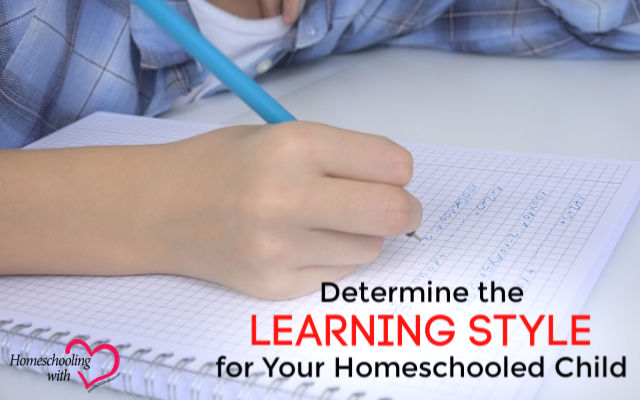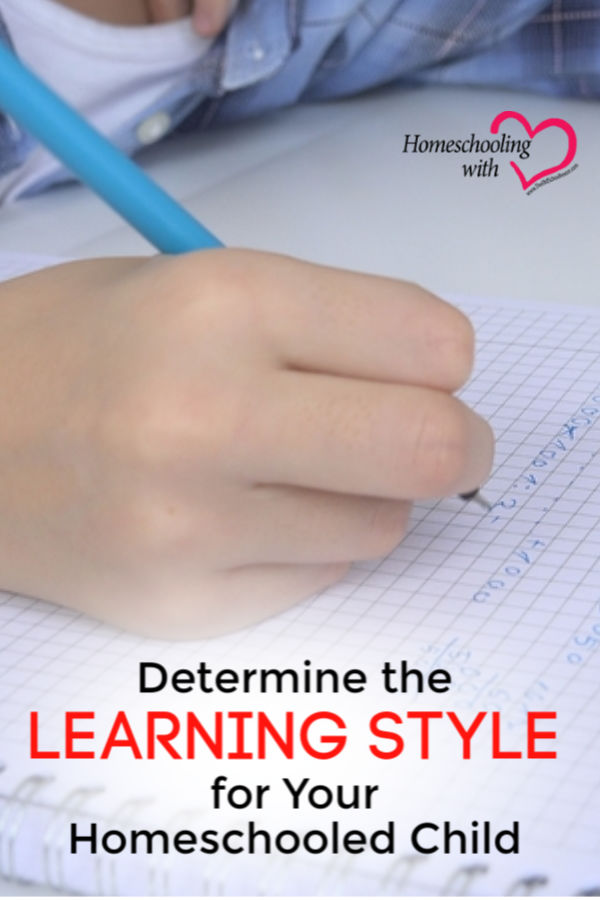Determine the Learning Style for Your Homeschooled Child


Students love to learn! You may doubt the veracity of this statement if your child struggles scholastically and claims to hate school, but a dislike of school does not mean a dislike of learning. It may be that your student’s classroom experience is not matching up with his/her preferred learning style. If you are a home educator, it is crucial to understand the various learning styles for homeschool.
The fact that a particular book or curriculum worked well with your first child is no guarantee that it will work equally well for the kids who follow. It is important to know each child’s learning style and adjust your teaching style accordingly. For this to work, it also helps to understand your own preferred style of learning. We tend to teach the way we prefer to be taught, but our children may best learn in a different way.
In 1992, Fleming and Mills developed the VARK Modalities theory, which outlines four basic learning styles: Visual, Aural/Auditory, Read/Write, and Kinesthetic. There is some overlap between them, and most students excel best with a combination of styles, depending on the setting and subject. However, these four categories offer a general overview of the four main ways that people like to learn. In this article, we will consider them as learning styles for homeschool.
Visual Learners
- Key Characteristics: Also known as the “spatial” learning style, these students learn best by seeing and observing. They tend to be doodlers, list-makers, and note-takers. They are quiet “copy-cats” who like to see a demonstration of what is expected of them. Their powers of observation make them extremely skilled at spotting details and catching errors that others miss.
- Homeschool Teaching Tips: Use presentations, handouts, and a whiteboard in your teaching! Incorporate lots of pictures and diagrams. Give them extra time to process all the details they are seeing, and then gently coax them into answering questions out loud.
Auditory Learners
- Key Characteristics: Compared to the other learning styles for homeschool, auditory students may be some of the best listeners, but be forewarned—they also love to talk! They learn by hearing and that includes hearing the sound of their own voice. Rather than take copious notes, they prefer simply to listen to a lecture and repeat what they hear the teacher say. They may be slower readers and poor test-takers, but they are willing to speak up in class, and they explain things well.
- Homeschool Teaching Tips: If you are teaching more than one student, encourage much group discussion! As you teach, get your students to repeat key words and phrases that you present. Get them to read out loud. When they are solving problems, encourage them to talk things out. Utilize music and videos in your teaching, and give your kids a lot of verbal praise!
Read/Write Learners
- Key Characteristics: These students learn best from written words—by reading words that others have written and also by writing words to express what they have learned from their reading. When there is something they need to know, they will look it up on the Internet and read articles about it. They excel at research and writing essays.
- Homeschool Teaching Tips: From a teacher’s perspective, this is perhaps the easiest one of the learning styles for homeschool. Simply get them reading and writing! Provide access to a lot of books and to the all-important dictionary. Allow them ample time to read and write, so they can fully absorb what they read and then compose their thoughts on paper.
Kinesthetic Learners
- Key Characteristics: These kids do not like to sit still! They prefer to keep moving and touch everything as they go. They are “tactile” learners, who learn best by doing (i.e. they learn from experience).
- Homeschool Teaching Tips: Get them moving! Give them hands-on experience, and when possible, let them touch and handle the items they are studying. Field trips to museums, science centers, and historic locations are excellent for these students (and also for the visual learners). When you need to be in the classroom, use learning games that involve movement and get them to act out events from history. It will also help them if you move while you teach. When your kids do finally settle down for some bookwork, you will need to give them frequent breaks to move around and use up some energy.
More Information on Learning Styles for Homeschool
These four styles are defined further in an article by Lauren Elrick, written for Rasmussen College on 4 Types of Learning Styles: How to Accommodate a Diverse Group of Students. The VARK model is one way of outlining learning styles, but there are others. For example, learning-styles-online.com gives an overview of seven learning styles: visual (spatial), aural (auditory-musical), verbal (linguistic), physical (kinesthetic), logical (mathematical), social (interpersonal), and solitary (intrapersonal). An HSLDA article by Inge P. Cannon groups learning styles into three simple categories: Lookers (visual/spatial learners), Listeners (auditory learners), and Movers (kinesthetic/tactile learners).
Learning Styles for Homeschool at SchoolhouseTeachers.com
SchoolhouseTeachers.com is the full-curriculum website of The Old Schoolhouse® Magazine. You have likely heard that one Ultimate Membership grants an entire family unlimited access to more than 400 online, self-paced courses covering PreK to Grade 12. What you may not know is that the website also has courses Just for Parents! Here are two that offer further teaching on learning styles:
- Your Child’s Learning Style. This course contains eight articles on learning styles for homeschool.
-
- How Does Your Child Learn Best: Traits of Various Types of Learners
- What Are Learning Styles
- The Benefits of Multi-Sensory Spelling Instruction
- The Biology of Auditory Processing and Short-Term Memory Issues
- Homeschooling: A Natural Fit for the Kinesthetic Child
- Finding a Fit in the Imperfect – Adapting Curricula to Suit Your Needs
- Play Your Way through Learning
- Homeschooling a Struggling Learner: How Do I Find the Time?
- Kinetic Connections. This course contains twenty-seven articles to help parents take a hands-on approach to teaching:
-
- Holidays, Seasons, and Special Occasions
- Math
- Science
- History and Geography
- Reading and Language Arts
Conclusion
It is worth noting that one of the reasons to homeschool is also one of the benefits of homeschooling: You are the one who knows your child the best! The longer you teach your child, the better you will understand his/her preferred learning style and the better teacher you will become!












































